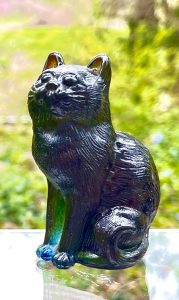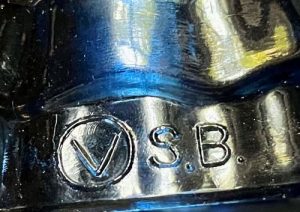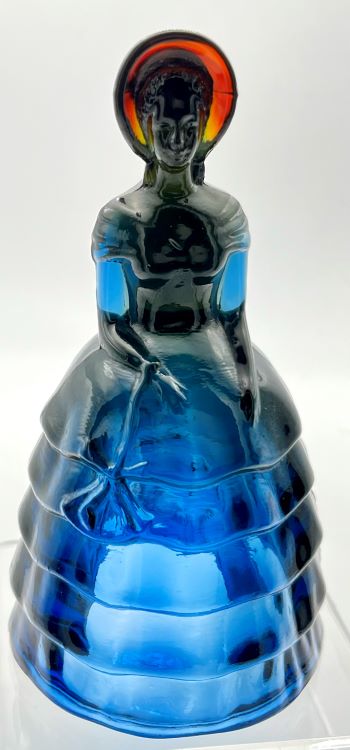 One of the most sought-after glass cat collectibles is Mosser Glass’ vintage sitting cat in the color rubina. Made as a special order in the early 1980’s, the rubina cat is easily mistaken for a very dark green, brown or black. But hold it up to the light and the rubina rainbow of color appears – red to gold through the ears, green shading to blue through the front legs and feet. Beautiful, unusual, and hard to find, these kitties have commanded premium prices – one selling recently for over $800 in heavy bidding at an online auction!
One of the most sought-after glass cat collectibles is Mosser Glass’ vintage sitting cat in the color rubina. Made as a special order in the early 1980’s, the rubina cat is easily mistaken for a very dark green, brown or black. But hold it up to the light and the rubina rainbow of color appears – red to gold through the ears, green shading to blue through the front legs and feet. Beautiful, unusual, and hard to find, these kitties have commanded premium prices – one selling recently for over $800 in heavy bidding at an online auction!
Rubina is an expensive and tempermental color to produce. Few glassmakers dabbled in it, and most collectors assume this cat was a “one off” for Mosser.
But Mosser made another rubina piece – although it was not marked Mosser or sold by Mosser Glass.
The process to create multicolored rubina glass was invented by Cambridge Glass Company in the 1920’s. A number of renowned glassmakers of the 20th century learned their craft working at Cambridge. One of them was Thomas Mosser, whose father Orie had been Cambridge’s plant manager.
Russel Vogelsong never worked at a glass factory, but his grandparents had both worked at Cambridge and he inherited some lovely pieces of glass from them. By the time Russ and his wife JoAnn opened Summit Glass in 1972, they were avid collectors and Russell had some ideas about how to effectively market glass. With no factory of their own until 1984, they acquired moulds from other companies and paid area glassmakers to press items for them to sell in their gift shop. They were also among the first to commission “private moulds” to be made for them and pressed elsewhere. For the Vogelsongs, “elsewhere” was usually Tom Mosser’s company, Mosser Glass.
Glass dolls in the style of colonial and “southern belle” figures had become popular around the late 1970’s. Vogelsong wanted to sell one of his own in a limited series of different colors. He commissioned Tom Mosser to design a mould for him, and Mosser created one based upon a 19th century Dresden doll.
But what to call her? Summit Glass held a naming contest, open to the public. Russell’s marketing skills were at work here – this clever move also gave them free publicity! The winner would receive a small cash prize, get every doll in the series for free, and have their initials added to the mould. The winning entry, “Melanie”, was sent in by Shirley Brown from California – the letters “SB” can be found on the Melanie dolls right beside Summit’s “V” in a circle mark.

Melanie was issued in a series of 24 colors – a different color every month (and 2 additional Mother’s Day bells) for 24 months beginning in 1980. All of the Melanie dolls were pressed at Mosser. The first color produced was called “Tom’s Surprise”, which was made on August 21, 1980.
And Tom Mosser’s “surprise?” This rubina glass doll!

